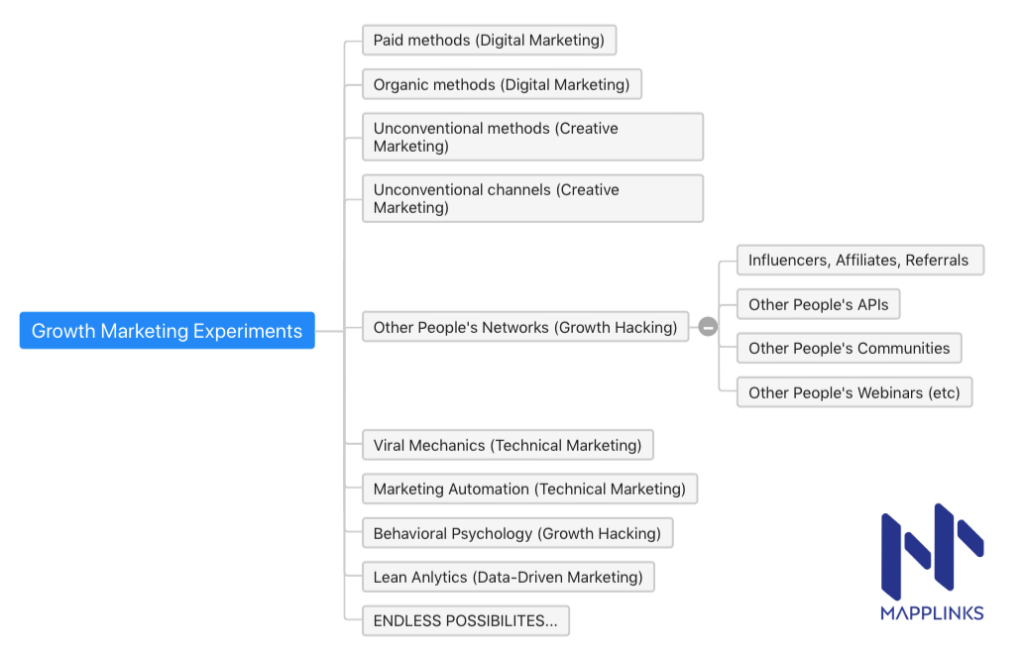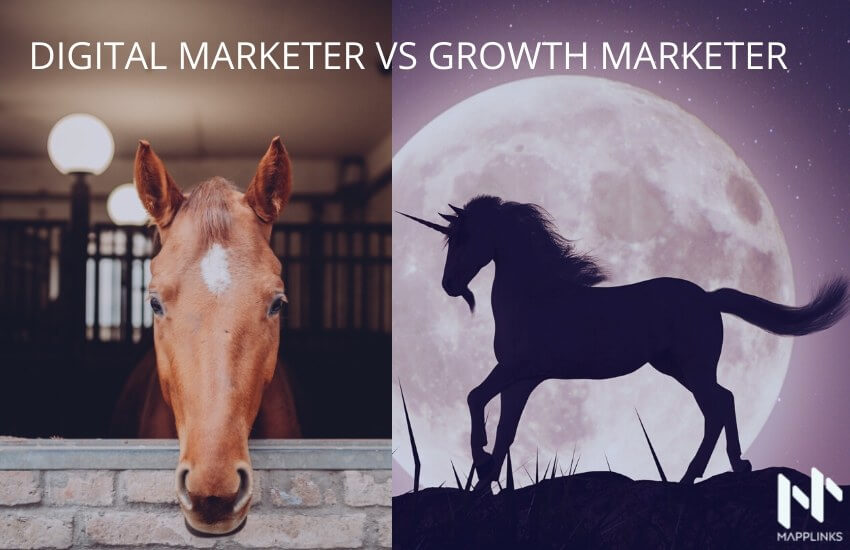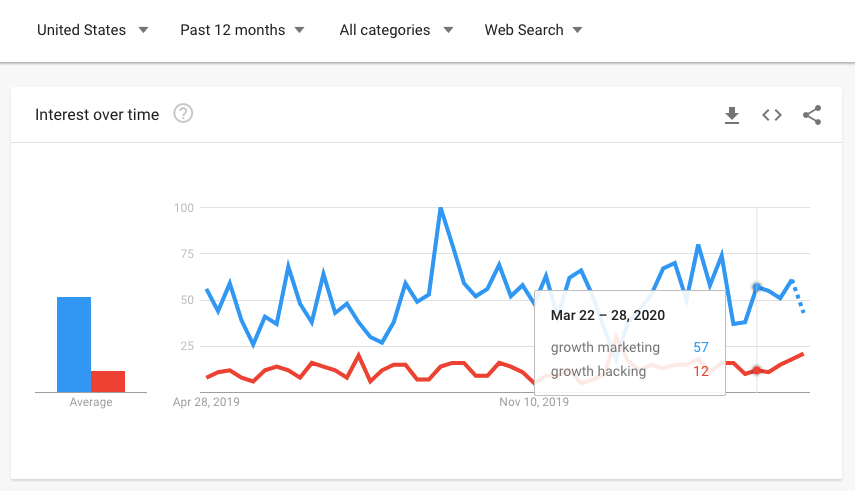Growth Marketing vs Digital Marketing vs Growth Hacking: What are the differences? Growth Marketing, Digital Marketing, and Growth Hacking are often confused with each other. And then we also have technical marketing, data-driven marketing, as well as “creative marketing”. This article will explain the differences: growth marketing vs digital marketing vs growth hacking.
So in this article, I will explain all the terms and clear the confusion among them and explain how they’re used and applied.
First things first:
Growth Marketing is the superset of them all
Growth Marketing principles make it the superset of all the other forms of marketing including digital marketing and growth hacking.
Here’s a quick reference to explain how all other forms of marketing fit into growth marketing as different “growth marketing experiments“.

As you can see, growth marketing includes many experiments including:
- Digital Marketing (Example: paid and organic social media, paid and organic search)
- Growth Hacking (Example: Other people’s networks (OPNs), behavioral psychology, creative hacks, CRO, A/B testing, lean and agile mindsets)
- Technical Marketing (Example: viral mechanics, marketing automation experiments)
- Data-Driven Marketing (using lean analytics in marketing and other data-driven experiments)
All of these fit very well into the growth marketing process as well as the growth marketing mindset.
One of the most common questions I get is “What is the difference between growth marketing and digital marketing?” and I hope this answers your question.
So, digital marketing is a subset of growth marketing.
Now, let’s deep dive into the process-related difference between growth marketing and digital marketing:
Deep Dive: Difference between Growth Marketing and Digital Marketing
Let’s learn this with an analogy.
Asking the difference between digital marketing and growth marketing is like asking the difference between a horse and a unicorn!
And let me explain why…
As a digital marketer, one will usually stay in the barn or the shed. Once outside, the horse runs straight to the destination taking the same path as all the other horses.
This is equivalent to targeting the most common and saturated channels all other marketers are focusing on. And running the campaigns long enough only to realize the results aren’t as expected rather late.
As a horse, you will also be, to some extent, think within the boundaries of these digital channels.
A unicorn, on the other hand, will experiment, be wild, execute faster, and try out new channels and paths each time. Some may think the unicorn is crazy and stays in a fantasy world.
But that’s where the unicorn will find amazing results faster and better in lesser budgets and lesser time than the horse.

It’s just the mindset shift and approach that changes how the process can get results. Here’s an overview of the process:
Growth Marketing vs Digital Marketing Process
The Digital Marketing Process
- Identify the goals of the brand
- Create user personas
- Create a campaign strategy
- Execute on popular channels
- Analyze campaign metrics
The Growth Marketing Process
- Identify one single goal to focus on at a time (called the north star metric)
- Create user personas
- Create channel personas (what kinds of platforms the users hang out on? or what other apps the users install? what are the OPNs I can leverage to find my user personas?)
- Use data and gut feeling to brainstorm creative growth experiments
Execute on selected, often offbeat channels, and analyze the north star metric - Integrate the successful experiments into their process
- The last step in the above process is where even the most experienced growth marketers and startups fail. And I’ve found that very process-integration key to scalable growth (more on that in the coming posts)
So given the level of experimentation, the scope of trying new channels based on channel personas, and going outside of the popular track makes a unicorn what it is – MAGICAL!
Deep Dive: Difference between Growth Marketing and Growth Hacking
As we’ve already established Growth Hacking is a subset of Growth Marketing and growth hacks can be designed and tested as growth marketing experiments.
In the startup ecosystem, this difference may not be very clear and some people might use these terms interchangeably, I use the term growth marketing and stopped using the term growth hacking to describe my work as it didn’t fit in all the experiments, frameworks, mindsets and principles I was using.
Here are other reasons why ‘Growth Marketing’ is a better term to use than ‘Growth Hacking’:
- It’s not about the hacks. Hacks are just fun toys for a unicorn. I want you to replace the word “hacks” in your growth vocabulary with the term “experiments”.
- Growth Hacking comes with all kinds of misconceptions.
- Google Trends for the USA and the world has a clear winner which is ‘Growth Marketing’ over the past 12 months data.

In terms of the way the terms are used in the ecosystem, there is no difference and most people will just prefer one term over the other. And “most people” won’t have detailed process documentation for their own work – whether it is growth marketing or growth hacking – so it doesn’t matter what term they use.
Deep Dive: Channel Personas
Growth Hackers and Growth Marketers both use Channel Personas while Digital Marketers use only User Personas and then usually execute their campaigns on the most popular (and often, saturated digital marketing channels).
While creating user personas is an essential step of a marketing strategy, traditional digital marketers tend to be blind toward exploring channel personas. It’s limit them to the most common channels for executing their campaigns.
“Marketers create user personas, Growth hackers also create Channel personas.”
Firstly, we need to define two new terms here before moving on with the rest of the article:
Term #1:
Traditional Digital Marketers
Term used for digital marketers in general by a growth hacker. For a growth hacker, modern digital marketing is also traditional.
Term #2:
Channel Personas
A definition with Characteristics of the kinds of channels we can execute creative campaigns on and reach the right Target Audience.
Now, let’s look at what a typical digital marketing process looks like:
Digital Marketing Process
- Identify goals of the brand
- Create user personas
- Create a campaign strategy
- Execute on popular channels
- Analyse campaign metrics
Though there might be various steps in the process on different blogs and website. But this is what really happens. The channel set is usually defined based on where the brand is already active if it has an existing digital strategy. OR a new set of channels is defined based on if it’s a B2B or B2C target.
Digital marketers usually play around with a common & popular set of channels like Facebook, LinkedIn, Twitter, Instagram. Rarely social media campaigns are executed beyond this set. While SEM campaigns run across the major advertising platforms like SM Ads and Google Adwords from data gathered across most digital marketing campaigns.
In comparison, let’s have a look at the growth hacking process:
Growth Hacking Process
- Identify one single goal which is defined using the OMTM or North Star Metric
- Create user personas
- Create CHANNEL PERSONAS
- Use data and gut feeling to brainstorm creative growth experiments
- Prioritise experiments based on their ICE Score and other prioritisation frameworks
- Execute on selected, often offbeat channels, and analyse OMTM
- Scale the successful experiments to growth hacks
Step 3 in the above process is the real differentiator between a digital marketer’s approach and a GROWTH MINDSET.
The growth hacker thinks beyond the default marketing channels to get better results, with less time and money.
WHY CHANNEL PERSONAS?
As a growth hacker, it’s essential to leverage channels outside of the usual playground. To explore beyond the default set of channels, Growth Hackers Create Channels Personas.
But here’s why we need to think beyond the popular channels in the first place:
- The most popular channels are expensive and saturated
- There are higher chances for successful growth hacking experiments in channels which are in the early-adopters peak
- A channel’s effectiveness typically reduces over time
- Offbeat and new channels are mostly cheaper than saturated ones, thus reducing investment and increasing the growth marketing ROI
- Multiple micro-channels mapped with the Target Audience are better than a single macro-channel with no TA focus
- It’s easier to target the right user segment with micro-channels VS paying for targeting on Facebook or other larger channels
- A new or offbeat channel probably has loopholes which Growth Hackers can leverage on compared to a mature channel
Example #1: Airbnb “growth hacked” Craigslist. It was not a traditional marketing or Facebook Ads campaign.
Example #2: PayPal “growth hacked” eBay. It was not an Adwords or a app advertising campaign.
Growth Hacking beats digital marketing in a ecosystem. Where our focus is on achieving results in less time and money, faster and better. And channel personas are key to cause this differentiator. At Mapplinks, we’ve helped many of our startup clients to optimise results by moving focus toward offbeat channels to get results.
The idea is to think beyond the channels given to us. And instead brainstorm using Channel Personas to find new channels to target as OPNs (Other People’s Networks) or growth hacking channels for our creative experiments. It always pays off to “DOUBT THE DEFAULT”.
HOW TO CREATE CHANNEL PERSONAS?
Channel personas are sets of definitions of the “kinds of channels” which the growth experiments would benefit the most from. While it’s easy to think about the usual suspects like in the case of social media channels. But it requires much more thinking to come up with specific TA-focused channels to run growth hacking experiments on.
To start thinking about target channel personas, it’s good to start by asking:
Q1. What kind of problem would the channel solve for a similar target audience as mine?
Q2. What are the other interests of my target audience? Where do people with similar interest hang out online?
Q3. What are some of the other brands, products or tools my TA follows on social media?
Q4. Where does the same age group hang out other than the standard social media channels?
Q5. What are the new channels which have been trending on Google Play or the App Store for the past few weeks?
Q6. What are the new communities or networks on ProductHunt or BetaList?
Q7. Which platforms and marketplaces have recently received PR or funding?
Q8. Which tools or networks are review bloggers in my network also writing about?
Q9. Which channels are my early users coming from?
Q10. What channels are my competitors or brands with similar TA running growth hacking experiments on?
Airbnb’s answer to Q9, for instance, was Craigslist. Not any of the usual social media or advertising platforms.
You will be surprised to know a lot more about your TA and discover a set of new high-impact low-cost channels if you ask yourself the above questions.
CONCLUTION
In summary, these should give you a list of channels which you should target your growth hacking campaigns on. Remember, Growth hackers think beyond the usual set of channels and campaigns. It’s to get better results faster and with less experiments. What’s key here is building the growth mindset.
If you want more information on how to build your channel personas, or any step of the growth hacking process, tweet to @reachrishabh and start a conversation.



